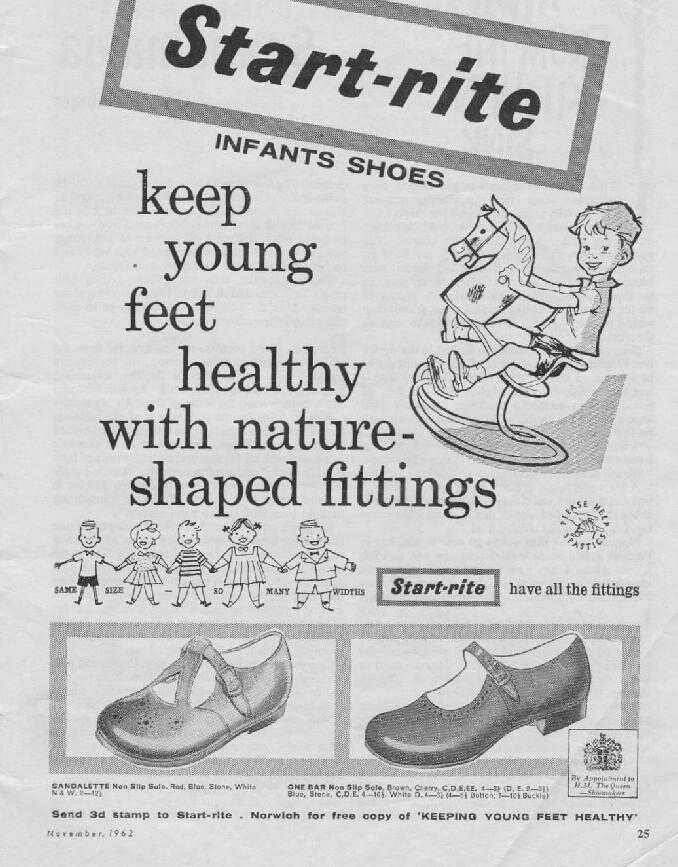
Start-rite Infant's Shoes (England, 1962)

Figure 1.--Start-rite was an important British manufacturer of children's shoes. This advertisement for Start-rite infant shoes appeared in the November 1962 issue of 'Parenting' magazine. It offered various styles of strap shoes for younger children. The British term 'infants' means todlers and younger primary school children.
|
|
Styles of strap shoes were widely worn by English children, including primary children in the 1960s. Even older girls continued wearing the single-bar strap shoes.A "T"-strap shoe was referred to as school sandals. May girls wore single-bar shoes to school. This was not common for boys, but pre-school boys did wear single-bar strap shoes. Start-rite was an important British manufacturer of children's shoes based in Norwich. The company dates back to the late-18th century when the modern British shoemaking industry picking up industrial revolution methods was born. James Smith was a cordwainer (leather worker) who began to offer inexpensive ready-made shoes. Start-rite continues to be one of the major British manufacturers of children's footwear. This An advertisement for Start-rite infant shoes appeared in the November 1962 issue of Parenting magazine. It offered various styles of strap shoes for younger children.
Strap Shoes
Styles of strap shoes were widely worn by English children, including primary children in the 1960s. Tgey were more popular for boys in in Britain than in America. Even older girls continued wearing the single-bar strap shoes.A "T"-strap shoe was referred to as school sandals. May girls wore single-bar shoes to school. This was not common for boys, but pre-school boys did wear single-bar strap shoes.
Start-rite was an important British manufacturer of children's shoes based in Norwich. The company dates back to the late-18th century when the modern British shoemaking industry picking up industrial revolution methods was born. James Smith was a cordwainer (leather worker) who began to offer inexpensive ready-made shoes. Start-rite continues to be one of the major British manufacturers of children's footwear.
Parents Magazine
This An advertisement for Start-rite infant shoes appeared in the November 1962 issue of Parenting magazine. This was an important British magazine. In included all kinfs of articles about parenting and children. There were also many advertisements for clothing, primarily younger children's clothing.
Infants
The British term 'infants' means todlers and younger primary school children.
Seasonality
Notice that the ad was placed in the November issue of Parenting. This means that they were standard children's shoes and not summer styles.
Gender
The ad copy does not address gender, but you can see by the illustrations that the choes were offered for both boys and girls. The older sizes would have been purchased mostly for girls. These are not the styles boys wore to school, although girls might have worn them to school.
Items Offered
The ad offered two different styles of strap shoes for younger children. These were only twon of the different styles the company offered. The ad copy read, "Start-rite infants shoes keep young feet healthy with nature-shaped fittings".
Sandalette
The ad copy read, "Sandalette Non Slip Sole. Red, blue, stone, white N & W." N & W we believe means narrow and wide. They were made in sizes 2-12 1/2. We are not sure what that means in age terms.
One-bar
The ad copy read, "One Bar Non Slip Sole. Brown, cherry. C, D, E, EE (4- 3 1/2), D, E (2-3 1/2). Blue, stone C, D, E (4-10 1/2), White D (4-3 1/2), (4-6 Button; 7-10 1/2 Buckle)." This is a little confusing, but suggests that there were button closures for the younger children and buckle closures for the older children.
Booklet
Start-rite offered parents a booklet, 'Keeping young feet healthy'.
Royal Seal
Notice the seal in the lower right hand corner of the Start-rite advertisement. Start-rite was authorized to make shoes for the royal family. Prince Charles and Princess Anne wore them in the 1950s. I'm not sure about Pribce Andrew and Prince Edward in the 60s, but Diana chose them for Prince William and Prince Harry in the 1990s.
Fastners
The age difference for buttons nd buckles is interesting. An American reader writes, "Buttons were probably easier for small children (and faster for mothers) than fastening buckles. I saw a British movie in which the mother was putting strap shoes on her 2-year old son, and she had the buttons fastened in a wink of the eye. I remember our children wearing high top shoes at that age in the USA, and they took much longer to put on and take off."
HBC

Navigate the Boys' Historical Clothing catalog/magazine pages:
[Return to the Main English 1962 catalog page]
[Return to the Main English 1960s catalog page]
[Return to the Main English mail order chronology page]
[Main photo/publishing page]
[Store catalogs]
[Fashion magazines]
Navigate the Boys' Historical Clothing Web Site:
[Introduction]
[Activities]
[Biographies]
[Chronology]
[Clothing styles]
[Countries]
[Bibliographies]
[Contributions]
[FAQs]
[Glossary]
[Images]
[Links]
[Registration]
[Tools]
[Boys' Clothing Home]
Navigate the Boys' Historical Clothing Web Site:
[Sailor suits]
[Sailor hats]
[Buster Brown suits]
[Eton suits]
[Rompers]
[Tunics]
[Smocks]
[Pinafores]
Created: 9:26 PM 9/17/2010
Last updated: 7:18 AM 11/27/2010



